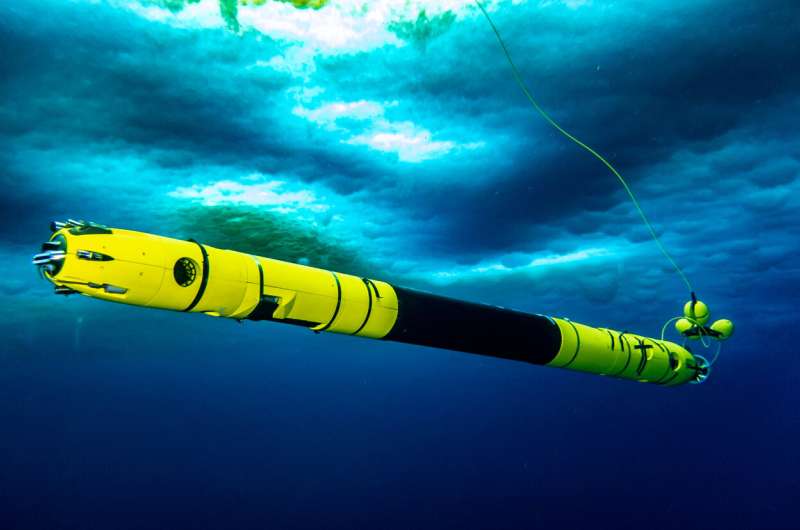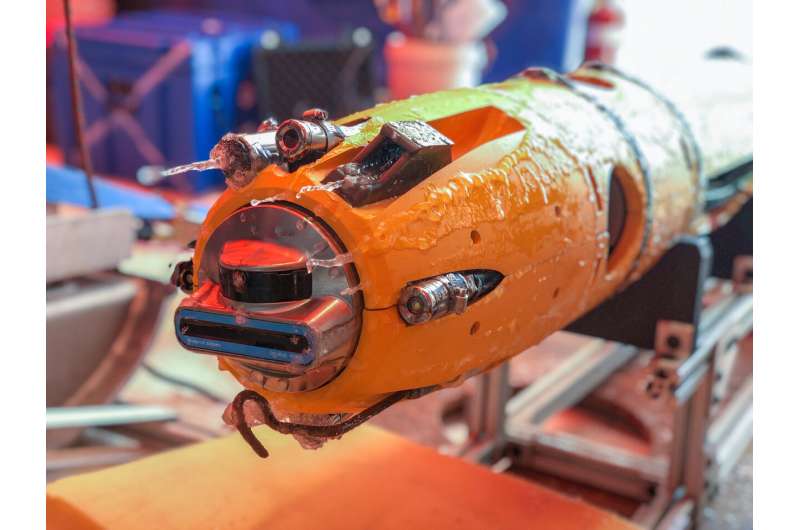This article has been reviewed according to Science X's editorial process and policies. Editors have highlighted the following attributes while ensuring the content's credibility:
fact-checked
peer-reviewed publication
trusted source
proofread
Underwater robot finds new circulation pattern in Antarctic ice shelf

More than merely cracks in the ice, crevasses play an important role in circulating seawater beneath Antarctic ice shelves, potentially influencing their stability, finds Cornell University-led research based on a first-of-its-kind exploration by an underwater robot.
The remotely operated Icefin robot's climb up and down a crevasse in the base of the Ross Ice Shelf produced the first 3D measurements of ocean conditions near where it meets the coastline, a critical juncture known as the grounding zone.
The robotic survey revealed a new circulation pattern—a jet funneling water sideways through the crevasse—in addition to rising and sinking currents, and diverse ice formations shaped by shifting flows and temperatures. Those details will improve modeling of ice shelf melting and freezing rates at grounding zones, where few direct observations exist, and of their potential contribution to global sea-level rise.
"Crevasses move water along the coastline of an ice shelf to an extent previously unknown, and in a way models did not predict," said Peter Washam, a polar oceanographer and research scientist at Cornell University. "The ocean takes advantage of these features, and you can ventilate the ice shelf cavity through them."
Washam is the lead author of "Direct Observations of Melting, Freezing and Ocean Circulation in an Ice Shelf Basal Crevasse," published in Science Advances.
The scientists in late 2019 deployed the Icefin vehicle—roughly 12 feet long and less than 10 inches around—on a tether down a 1,900-foot borehole drilled with hot water, near where Antarctica's largest ice shelf meets the Kamb Ice Stream. Such so-called grounding zones are key to controlling the balance of ice sheets, and the places where changing ocean conditions can have the most impact.
On the team's last of three dives, Matthew Meister, a senior research engineer, drove Icefin into one of five crevasses found near the borehole. Equipped with thrusters, cameras, sonar and sensors for measuring water temperature, pressure and salinity, the vehicle climbed nearly 150 feet up one slope and descended the other.
The survey detailed changing ice patterns as the crevasse narrowed, with scalloped indentations giving way to vertical runnels, then green-tinted marine ice and stalactites. Melting at the crevasse base and salt rejection from freezing near the top moved water up and down around the horizontal jet, driving uneven melting and freezing on the two sides, with more melting along the lower downstream wall.

"Each feature reveals a different type of circulation or relationship of the ocean temperature to freezing," Washam said. "Seeing so many different features within a crevasse, so many changes in the circulation, was surprising."
The researchers said the findings highlight crevasses' potential to transport changing ocean conditions—warmer or colder—through an ice shelf's most vulnerable region.
"If water heats up or cools off, it can move around in the back of the ice shelf quite vigorously, and crevasses are one of the means by which that happens," Washam said. "When it comes to projecting sea-level rise, that's important to have in the models."
More information: Peter Washam et al, Direct observations of melting, freezing, and ocean circulation in an ice shelf basal crevasse, Science Advances (2023). DOI: 10.1126/sciadv.adi7638. www.science.org/doi/10.1126/sciadv.adi7638
Journal information: Science Advances
Provided by Cornell University




















